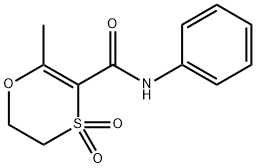Chemical Properties
Oxydisulfoton is a white corrosive solid.
Definition
ChEBI: An anilide obtained by formal condensation of the amino group of aniline with the carboxy group of 2-methyl-5,6-dihydro-4,4-dioxo-1,4-oxathiine-3-carboxylic acid. A fungicide for the control of rust diseases on ornamentals, cereals and nursery trees as wel
as fairy rings on turf.
Agricultural Uses
Fungicide: Registered as a foliar systemic fungicide for use
against rust on carnations and greenhouse geranium. Not
approved for use in EU countries. Registered for use in
the U.S. and Canada
Trade name
CARBOJECT®[C]; DYNAM®; F461®;FUNGISOL®[C]; PLANTVAX®; PLANT WAX®;
VITAVEX®
Metabolic pathway
The oxathiin ring of the oxycarboxin undergoes a
glass-catalyzed ring-opening reaction resulting in a
simple step for hydrolytic removal of an acetyl group
to give 2-(vinylsulfonyl)acetanilide in aqueous solution.
The decomposition of oxycarboxin involves the
container and is surface-type dependent.
Shipping
UN3077 Environmentally hazardous substances,
solid, n.o.s., Hazard class: 9; Labels: 9-Miscellaneoushazardous
material, Technical Name Required. UN1596 Dinotoanilines,
Hazard Class: 6.1; Labels: 6.1-Poisonous materials.
Incompatibilities
May react with strong oxidizers such as
chlorates, peroxides, and nitrates. Can become unstable in
acidic and alkaline media. Combustible; dust may form
explosive mixture with air. Corrosive, may attack some
metals, rubbers, and plastics.
Waste Disposal
Do not discharge into drains or
sewers. Dispose of waste material as hazardous waste using
alicensed disposal contractor to an approved landfill. Consult
with environmental regulatory agencies for guidance on acceptable disposal practices. If allowed, Incineration with
effluent gas scrubbing is recommended. Containers must be
disposed of properly by following package label directions or
by contacting your local or federal environmental control
agency, or by contacting your regional EPA office.

